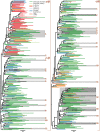HIV-genetic diversity and drug resistance transmission clusters in Gondar, Northern Ethiopia, 2003-2013
- PMID: 30304061
- PMCID: PMC6179264
- DOI: 10.1371/journal.pone.0205446
HIV-genetic diversity and drug resistance transmission clusters in Gondar, Northern Ethiopia, 2003-2013
Abstract
Background: The HIV-1 epidemic in Ethiopia has been shown to be dominated by two phylogenetically distinct subtype C clades, the Ethiopian (C'-ET) and East African (C-EA) clades, however, little is known about the temporal dynamics of the HIV epidemic with respect to subtypes and distinct clades. Moreover, there is only limited information concerning transmission of HIV-1 drug resistance (TDR) in the country.
Methods: A cross-sectional survey was conducted among young antiretroviral therapy (ART)-naïve individuals recently diagnosed with HIV infection, in Gondar, Ethiopia, 2011-2013 using the WHO recommended threshold survey. A total of 84 study participants with a median age of 22 years were enrolled. HIV-1 genotyping was performed and investigated for drug resistance in 67 individuals. Phylogenetic analyses were performed on all available HIV sequences obtained from Gondar (n = 301) which were used to define subtype C clades, temporal trends and local transmission clusters. Dating of transmission clusters was performed using BEAST.
Result: Four of 67 individuals (6.0%) carried a HIV drug resistance mutation strain, all associated with non-nucleoside reverse transcriptase inhibitors (NNRTI). Strains of the C-EA clade were most prevalent as we found no evidence of temporal changes during this time period. However, strains of the C-SA clade, prevalent in Southern Africa, have been introduced in Ethiopia, and became more abundant during the study period. The oldest Gondar transmission clusters dated back to 1980 (C-EA), 1983 (C-SA) and 1990 (C'-ET) indicating the presence of strains of different subtype C clades at about the same time point in Gondar. Moreover, some of the larger clusters dated back to the 1980s but transmissions within clusters have been ongoing up till end of the study period. Besides being associated with more sequences and larger clusters, the C-EA clade sequences were also associated with clustering of HIVDR sequences. One cluster was associated with the G190A mutation and showed onward transmissions at high rate.
Conclusion: TDR was detected in 6.0% of the sequenced samples and confirmed pervious reports that the two subtype C clades, C-EA and C'-ET, are common in Ethiopia. Moreover, the findings indicated an increased diversity in the epidemic as well as differences in transmission clusters sizes of the different clades and association with resistance mutations. These findings provide epidemiological insights not directly available using standard surveillance and may inform the adjustment of public health strategies in HIV prevention in Ethiopia.
Conflict of interest statement
The authors have declared that no competing interests exist.
Figures


References
-
- WHO. Consolidated guidelines on the use of antiretroviral drugs for treating and preventing HIV infection: recommendations for a public health approach. http://apps.who.int/iris/bitstream/10665/208825/1/9789241549684_eng.pdf?.... 2016. PubMed PMID: 24716260. - PubMed
-
- Kityo C, Thompson J, Nankya I, Hoppe A, Ndashimye E, Warambwa C, et al. HIV Drug Resistance Mutations in Non-B Subtypes After Prolonged Virological Failure on NNRTI-Based First-Line Regimens in Sub-Saharan Africa. Journal of acquired immune deficiency syndromes. 2017;75(2):e45–e54. Epub 2017/01/28. 10.1097/QAI.0000000000001285 ; PubMed Central PMCID: PMCPMC5427983. - DOI - PMC - PubMed
-
- Hamers RL, Wallis CL, Kityo C, Siwale M, Mandaliya K, Conradie F, et al. HIV-1 drug resistance in antiretroviral-naive individuals in sub-Saharan Africa after rollout of antiretroviral therapy: a multicentre observational study. The Lancet Infectious diseases. 2011;11(10):750–9. Epub 2011/08/02. 10.1016/S1473-3099(11)70149-9 . - DOI - PubMed
Publication types
MeSH terms
Substances
Grants and funding
LinkOut - more resources
Full Text Sources
Medical
Molecular Biology Databases

